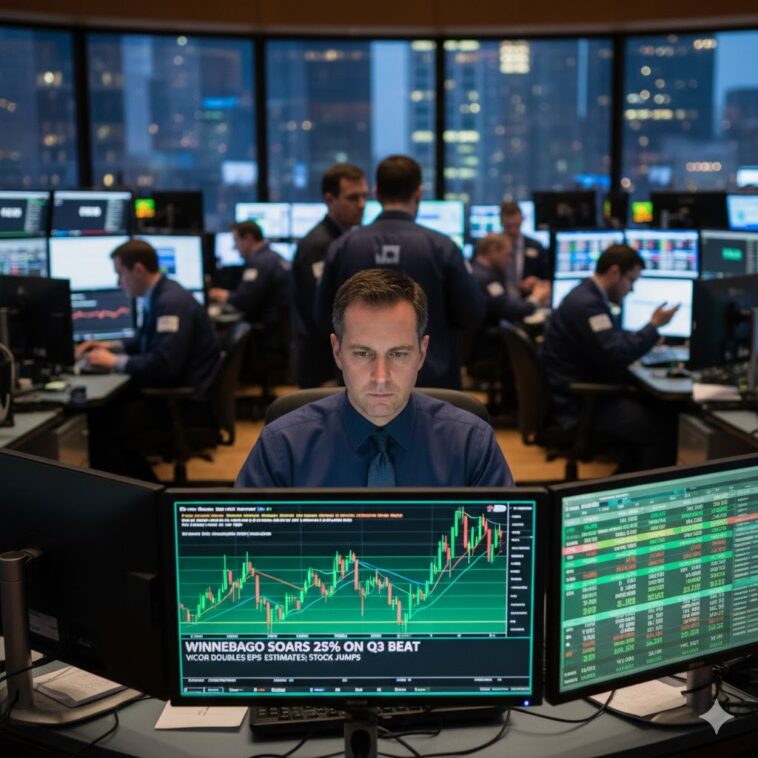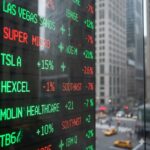A fierce dose of market volatility is gripping Wall Street, fueled by a dizzying mix of stellar quarterly earnings reports, major disappointments, and the ever-present specter of retail-driven frenzy. The movement was sharp, particularly in companies that either wildly overshot or narrowly missed the Street’s estimates, proving once again that in this environment, a beat or a miss isn’t just a number—it’s a catalyst.
The Blowout Beats: RVs, Robots, and Power Grids
The biggest stories of the day weren’t coming from the FAANG complex, but from more niche sectors where companies absolutely smashed expectations.
Take Vicor, the modular power component maker. They practically levitated, soaring a stunning 25% after their third-quarter earnings per share (EPS) more than doubled the Wall Street consensus. That’s not just a beat; it’s a rout.
Similarly, motorhome manufacturer Winnebago Industries hit the accelerator, rocketing over 25% following a powerful fiscal fourth-quarter report. The company reported adjusted EPS of $0.71, easily besting the $0.53 analysts had braced for. Revenue, too, cruised past estimates, landing at $777.3 million. It seems the post-pandemic craving for life on the open road hasn’t quite faded.
Then there was Intuitive Surgical, the high-end robotic surgery systems maker. Their stock popped 14% on the back of third-quarter results that flew past analyst targets, posting an adjusted EPS of $2.40 on $2.51 billion in revenue. “This is a classic ‘capex cycle’ play,” noted Sandra Lopez, a Director of Equity Research at Nexus Capital. “Intuitive’s blowout results signal that hospitals are not only financially healthy but are also willing to invest heavily in next-generation technology. That’s a powerful sign of confidence in the broader economy.”
Other winners included the vacation and hospitality sectors, with Travel + Leisure and Hilton Worldwide both enjoying a significant bump on stronger-than-expected results, an indication that consumer discretionary spending remains surprisingly resilient. Even the big banks saw a lift: both Capital One and regional lender Western Alliance rose on better-than-forecasted figures.
Red Flags and Meme Stock Mania
It wasn’t all celebrations. Chip titan Texas Instruments stumbled, dropping over 5%. While a 5% drop might not sound catastrophic, for a blue-chip name like TXN, it’s a warning. The company missed its EPS forecast by a cent and, more critically, delivered weak fourth-quarter profit guidance. When an industrial bellwether like TI signals a slowdown, the market pays attention.
The biggest story of disappointment, however, was Netflix. The streaming giant saw its shares plunge 10% after it posted a deeply underwhelming third-quarter EPS of $5.87, missing the LSEG-polled estimate of $6.97. Even matching revenue expectations wasn’t enough to soothe investors worried about the cost of maintaining content dominance.
Meanwhile, the surreal corner of the market continued its manic run. Beyond Meat surged another 29%, extending Tuesday’s massive 140%+ meme-fueled gain after signing a distribution deal with Walmart. Doughnut chain Krispy Kreme also gained 8% as retail traders flocked to high-speculative names. The whole thing feels disconnected from reality. “It’s pure momentum trading,” said financial blogger and market commentator Tony Chen. “Fundamentals? Who cares. When you see a company with zero revenue and a $20 billion market cap, like nuclear startup Oklo, whose stock dropped 14% on a report detailing its empty books, you realize many traders are just chasing the chart, not the company. It’s a high-stakes casino right now.”
Nuance and the Forward Look
The disparate results this quarterly earnings season paint a confusing picture: strong consumer spending is lifting travel and hospitality, but industrial chips and mega-cap media are flashing caution. The dichotomy is jarring.
British bank Barclays, for its part, tried to inject confidence, rising 5% after announcing a $500 million share buyback and raising its return on tangible equity guidance. It’s a classic signal of financial strength, but it begs the question: how much of this quarter’s success is due to genuine operational excellence and how much is merely shrewd financial engineering?
In the end, this earnings season proves the market is less of a cohesive ship and more of a convoy of disparate vessels navigating a squall. Some are riding a clean wave of execution, others are taking on water due to macro headwinds, and a few are just being tossed about by an irrational social media tide.
“Investors need to be surgical,” advises Lopez. “The cost of missing earnings is higher than it’s been in years. We’re in a stock-picker’s market. You have to focus on the balance sheet, not the hype. Look for those firms, like BioAge Labs in biotech, that are gaining on a legitimate analyst upgrade tied to innovation. That’s a sign of lasting value, not just a day trade.”



